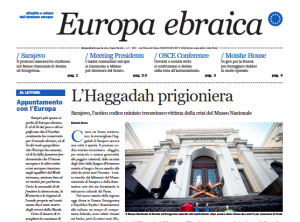MEDIA The First Pages of Europa Ebraica
“We talk about Jewish Europe more and more often. Aside from the significance that Europe has for the Jews, and the geopolitical role that the region and its institutions play, there are many other reasons to talk about it.” This is how the editor-in-chief of the editorial staff of the Union of Italian Jewish Communities Guido Vitale presents the creation of the new Europa Ebraica newspaper which is published in collaboration with the European Jewish Fund.
The first issue marks an attempt to gather together all news regarding Jewish Europe into a fully dedicated magazine. It is currently distributed with all the editions; printed and electronic, in the November issue of Pagine Ebraiche. Europa Ebraica was fortunate to have the first experimental issue of a magazine to be printed and distributed. This was made possible with no additional costs by inserting the new pages into a regular issue of Pagine Ebraiche, the magazine of chronicles from Italian Jewish Communities, Italia Ebraica and the magazine for children, DafDaf.
With its own graphics inspired by that of the Northern European press, it has its’ own personality and its’ own identity. “Europa Ebraica offers the reader the possibility to think about the best way of talking about Jewish Europe,” Vitale said. The magazine aims to portray various aspects of Jewish life in Europe: its institutions, the challenge of upholding the values of democracy and Memory, the complex relations with Israel as well as the concern of undertaking its defense. Europa Ebraica also has the duty to combat a new wave of anti-Semitism and the role of representing the presence of values and culture that the Jewish minority has always played.
It is already possible to find all of this and more by going through the contents of this first issue.
The conservation and the values of cultural heritage are the themes of the two stories on page one. The first is about the Beit Project, an initiative begun in Spain by the European Jewish Fund, emphasizing the salvation and the memory of sites which are in the public space of many European cities, just in front of our eyes, but remain completely unknown to its’ inhabitants and visitors to these places. The second feature tells the long story of the Sarajevo Haggadah, the priceless 14th-century manuscript from Spain’s Jewry’s Golden Age that survived inquisitions and the Holocaust, but now sits trapped in the shuttered Bosnian National Museum barred from public display.
At the center of the magazine there are two important international events:
The fifth Meeting of Presidents organized by the European Council of Jewish Communities and the American Jewish Joint Distribution Committee which will take place in Milan on November 21-23. This meeting will gather the leaders of Jewish communities from all around Europe for a three-day seminar. Just the week before in Berlin, the OSCE Conference on Anti-Semitism will discuss the challenges of anti-Semitism in the OSCE region ten years after the Berlin Declaration, bringing together government representatives of the 57 participating States and more than 150 representatives from civil society. Last but not least the story of Moishe House recounted by Jeremy Borovitz, cultural director of the organization, who took a long journey through Russia to build Sukkots all over the country.
New challenges and new stories await the next issues, “Because the appointment with Europe is an inevitable confrontation that the Jewish world doesn’t want to miss and can’t escape,” Vitale concludes.

